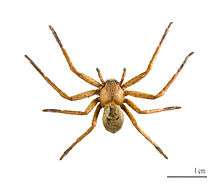Huntsman spider
Huntsman spiders, members of the family Sparassidae (formerly Heteropodidae), are known by this name because of their speed and mode of hunting. They are also called giant crab spiders because of their size and appearance. Larger species sometimes are referred to as wood spiders, because of their preference for woody places (forests, mine shafts, woodpiles, wooden shacks). In southern Africa the genus Palystes are known as rain spiders or lizard-eating spiders.[3] Commonly they are confused with baboon spiders from the Mygalomorphae infraorder, which are not closely related.
| Huntsman spiders | |
|---|---|
 | |
| Palystes castaneus, showing sparassid pattern of eyes in two rows of four, with the robust build and non-clavate pedipalps of a female. | |
| Scientific classification | |
| Kingdom: | Animalia |
| Phylum: | Arthropoda |
| Subphylum: | Chelicerata |
| Class: | Arachnida |
| Order: | Araneae |
| Infraorder: | Araneomorphae |
| Family: | Sparassidae Bertkau, 1872[1] |
| Diversity[2] | |
| 88 genera, 1363 species | |
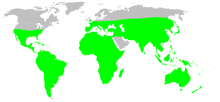 | |
More than a thousand Sparassidae species occur in most warm temperate to tropical regions of the world, including much of Australasia, Africa, Asia, the Mediterranean Basin, and the Americas.[4]
Several species of huntsman spider can use an unusual form of locomotion. The wheel spider (Carparachne aureoflava) from the Namib uses a cartwheeling motion, while Cebrennus rechenbergi uses a handspring motion.
Appearance
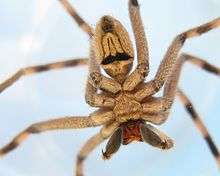
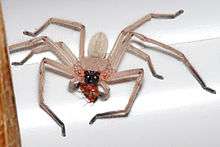
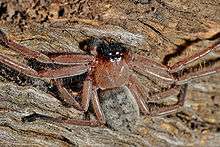
Sparassids are eight-eyed spiders. The eyes appear in two largely forward-facing rows of four on the anterior aspect of the prosoma. Many species grow very large – in Laos, male giant huntsman spiders (Heteropoda maxima) attain a legspan of 25–30 centimetres (9.8–11.8 in). Persons unfamiliar with spider taxonomy commonly confuse large species with tarantulas, but huntsman spiders can generally be identified by their legs, which, rather than being jointed vertically relative to the body, are twisted in such a way that in some attitudes the legs extend forward in a crab-like fashion.
On their upper surfaces the main colours of huntsman spiders are inconspicuous shades of brown or grey, but many species have undersides more or less aposematically marked in black-and-white, with reddish patches over the mouthparts. Their legs bear fairly prominent spines, but the rest of their bodies are smoothly furry. They tend to live under rocks, bark and similar shelters, but human encounters are commonly in sheds, garages and other infrequently-disturbed places. The banded huntsman (Holconia) is large, grey to brown with striped bands on its legs. The badge huntsman (Neosparassus) is larger still, brown and hairy. The tropical or brown huntsman (Heteropoda) is also large and hairy, with mottled brown, white and black markings. The eyesight of these spiders is not nearly as good as that of the Salticidae (jumping spiders). Nevertheless, their vision is quite sufficient to detect approaching humans or other large animals from some distance.
Size, venom and aggression
On average, a huntsman spider's leg span can reach up to 15 centimetres (5.9 in), while their bodies measure about 1.8 centimetres (0.71 in) long.[5]
Like most spiders, apart from the Uloboridae and some Liphistiidae and Holarchaeidae,[6] Sparassidae use venom to immobilize prey. They have been known to inflict serious defensive bites on humans.[7]
There have been reports of members of various genera such as Palystes,[8] Neosparassus (formerly called Olios) and several others, inflicting severe bites. The effects vary, including local swelling and pain, nausea, headache, vomiting, irregular pulse rate, and heart palpitations, indicating some systemic neurological toxin effects, especially when the bites were severe or repeated. However, the formal study of spider bites is fraught with complications, including unpredictable infections, dry bites, shock, nocebo effects, and even bite misdiagnosis by medical professionals and specimen misidentification by the general public.
It is not always clear what provokes Sparassidae to attack and bite humans and animals, but it is known that female members of this family will aggressively defend their egg sacs and young against perceived threats.[4] Bites from sparassids usually do not require hospital treatment.
Sound production in mating rituals
Males of Heteropoda venatoria, one of the huntsman spiders that seems to easily find its way around the world, have recently been found to deliberately make a substrate-borne sound when they detect a chemical (pheromone) left by a nearby female of their species. The males anchor themselves firmly to the surface onto which they have crawled and then use their legs to transmit vibrations from their bodies to the surface. Most of the sound emitted is produced by strong vibrations of the abdomen. The characteristic frequency of vibration and the pattern of bursts of sound identify them to females of their species, who will approach if they are interested in mating. This sound can often be heard as a rhythmic ticking, somewhat like a quartz clock, which fades in and out and can be heard by human ears in a relatively quiet environment.[9]
Genera
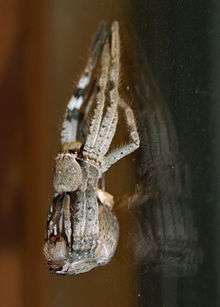
As of April 2019, the World Spider Catalog accepts the following genera:[10]
- Adcatomus Karsch, 1880 — Venezuela, Peru
- Anaptomecus Simon, 1903 — Central America, South America
- Anchonastus Simon, 1898 — Cameroon, Congo
- Arandisa Lawrence, 1938 — Namibia
- Barylestis Simon, 1910 — Africa, Asia, Europe
- Beregama Hirst, 1990 — Australia, Papua New Guinea
- Berlandia Lessert, 1921 — East Africa
- Bhutaniella Jäger, 2000 — Asia
- Caayguara Rheims, 2010 — Brazil
- Carparachne Lawrence, 1962 — Namibia
- Cebrennus Simon, 1880 — Africa, Asia, Malta
- Cerbalus Simon, 1897 — Israel, Jordan, Egypt
- Chrosioderma Simon, 1897 — Madagascar
- Clastes Walckenaer, 1837 — Indonesia, Papua New Guinea
- Curicaberis Rheims, 2015 — North America, Central America, Brazil
- Damastes Simon, 1880 — Madagascar, Mozambique, Seychelles
- Decaphora Franganillo, 1931 — North America, Caribbean, Central America, Colombia
- Defectrix Petrunkevitch, 1925 — Panama
- Delena Walckenaer, 1837 — Australia, New Zealand
- Dermochrosia Mello-Leitão, 1940 — Brazil
- Diminutella Rheims & Alayón, 2018 — Cuba
- Eusparassus Simon, 1903 — Asia, Africa, Europe, Peru
- Exopalystes Hogg, 1914 — Papua New Guinea
- Geminia Thorell, 1897 — Myanmar
- Gnathopalystes Rainbow, 1899 — Asia, Oceania
- Guadana Rheims, 2010 — Brazil, Peru, Ecuador
- Heteropoda Latreille, 1804 — Oceania, Asia, South America, Greece
- Holconia Thorell, 1877 — Australia
- Irileka Hirst, 1998 — Australia
- Isopeda L. Koch, 1875 — Australia, Philippines, Papua New Guinea
- Isopedella Hirst, 1990 — Australia, Papua New Guinea, Indonesia
- Keilira Hirst, 1989 — Australia
- Leucorchestris Lawrence, 1962 — Angola, Namibia
- Macrinus Simon, 1887 — South America, Tobago, United States
- Martensopoda Jäger, 2006 — India
- May Jäger & Krehenwinkel, 2015 — Namibia, South Africa
- Megaloremmius Simon, 1903 — Madagascar
- Micrommata Latreille, 1804 — Spain, Africa, Asia
- Microrchestris Lawrence, 1962 — Namibia
- Neosparassus Hogg, 1903 — Australia
- Neostasina Rheims & Alayón, 2016 — Caribbean
- Nisueta Simon, 1880 — Sudan, Ethiopia, Tanzania
- Nolavia Kammerer, 2006 — Brazil
- Nonianus Simon, 1885 — South America, Algeria, Israel
- Nungara Pinto & Rheims, 2016 — Brazil, Ecuador
- Olios Walckenaer, 1837 — Asia, South America, Oceania, Africa, Central America, North America, Caribbean
- Orchestrella Lawrence, 1965 — Namibia
- Origes Simon, 1897 — Argentina, Peru, Ecuador
- Paenula Simon, 1897 — Ecuador
- Palystella Lawrence, 1928 — Namibia
- Palystes L. Koch, 1875 — Africa, India, Australia
- Panaretella Lawrence, 1937 — South Africa
- Pandercetes L. Koch, 1875 — Asia, Oceania
- Parapalystes Croeser, 1996 — South Africa
- Pediana Simon, 1880 — Indonesia, Australia
- Pleorotus Simon, 1898 — Seychelles
- Polybetes Simon, 1897 — South America
- Prusias O. Pickard-Cambridge, 1892 — Brazil, Mexico, Panama
- Prychia L. Koch, 1875 — Papua New Guinea, Fiji, Philippines
- Pseudomicrommata Järvi, 1914 — Africa
- Pseudopoda Jäger, 2000 — Asia
- Pseudosparianthis Simon, 1887 — South America, Central America, Saint Vincent and the Grenadines
- Quemedice Mello-Leitão, 1942 — Brazil, Argentina
- Remmius Simon, 1897 — Africa
- Rhacocnemis Simon, 1897 — Seychelles
- Rhitymna Simon, 1897 — Asia, Africa
- Sagellula Strand, 1942 — Japan, China
- Sampaiosia Mello-Leitão, 1930 — Brazil
- Sarotesius Pocock, 1898 — East Africa
- Sinopoda Jäger, 1999 — Asia
- Sivalicus Dyal, 1957 — India
- Sparianthina Banks, 1929 — South America, Tobago, Central America
- Sparianthis Simon, 1880 — Colombia
- Spariolenus Simon, 1880 — Asia
- Staianus Simon, 1889 — Madagascar
- Stasina Simon, 1877 — South America, Gabon, Asia, Cuba
- Stasinoides Berland, 1922 — Ethiopia
- Stipax Simon, 1898 — Seychelles
- Strandiellum Kolosváry, 1934 — Papua New Guinea
- Thelcticopis Karsch, 1884 — Asia, Oceania, Africa
- Thomasettia Hirst, 1911 — Seychelles
- Tibellomma Simon, 1903 — Venezuela
- Tychicus Simon, 1880 — Philippines, Papua New Guinea, Indonesia
- Typostola Simon, 1897 — Australia, Papua New Guinea
- Uaiuara Rheims, 2013 — Panama, South America
- Vindullus Simon, 1880 — South America, Guatemala
- Yiinthi Davies, 1994 — Australia, Papua New Guinea
- Zachria L. Koch, 1875 — Australia
Distribution and habitat
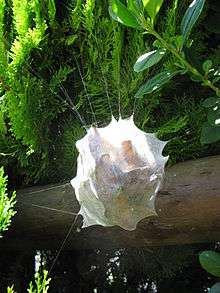
Members of the Sparassidae are native to tropical and warm temperate regions worldwide. A few species are native to colder climates, like the green huntsman spider (Micrommata virescens) which is native to Northern and Central Europe.[11] Some tropical species like Heteropoda venatoria (Cane huntsman) and Delena cancerides (Social huntsman) have been accidentally introduced to many subtropical parts of the world, including New Zealand (which has no native sparassid species).[12] The huntsman spiders found in southern parts of Florida are of the Heteropoda venatoria species and considered an invasive species transplanted from Asia.[13] Because of their speed, they commonly hunt and eat cockroaches and are found in many homes.[14]
As adults, huntsman spiders do not build webs, but hunt and forage for food: their diet consists primarily of insects and other invertebrates, and occasionally small skinks and geckos. They live in the crevices of tree bark, but will frequently wander into homes and vehicles. They are able to travel extremely quickly, often using a springing jump while running, and walk on walls and even on ceilings. They also tend to exhibit a "cling" reflex if picked up, making them difficult to shake off and much more likely to bite. The females are fierce defenders of their egg sacs and young. They will generally make a threat display if provoked, and if the warning is ignored they may attack and bite. The egg sacs differ fairly widely among the various genera. For example, in Heteropoda spp. egg sacs are carried underneath the female's body, while in other species like Palystes and Pseudomicrommata spp., females generally attach egg sacs to vegetation.[15]
See also
References
Inline citations
- "Family: Sparassidae Bertkau, 1872". World Spider Catalog. Natural History Museum Bern. Retrieved 2017-04-22.
- "Currently valid spider genera and species". World Spider Catalog. Natural History Museum Bern. Retrieved 2017-04-22.
- Norman Larsen. "Palystes (rain spiders, lizard-eating spiders)". Iziko Museums of Cape Town. Biodiversity Explorer. Retrieved 2 May 2010.
- Geoffrey K. Isbister & David Hirst (2003). "A prospective study of definite bites by spiders of the family Sparassidae (huntsmen spiders) with identification to species level". Toxicon. 42 (2): 163–171. doi:10.1016/S0041-0101(03)00129-6. PMID 12906887.
- "Huntsman Spider Devours Possum in Viral (and Terrifying) Photos". livescience.com. June 19, 2019.
- Foelix, Rainer; Erb, Bruno (2010). "Mesothelae have venom glands". Journal of Arachnology. 38 (3): 596–598. doi:10.1636/B10-30.1. ISSN 0161-8202.
- S. H. Skaife (1963). A Naturalist Remembers. Longmans South Africa. OCLC 11111496.
- D'Ewes, Dudley (1967). "Chapter 12". Wayward naturalist. Cape Town: Howard Timmins. OCLC 457367.
- Rovner, Jerome S. (1980). "Vibration in Heteropoda venatoria (Sparassidae): A Third Method of Sound Production in Spiders". The Journal of Arachnology. 8 (2): 193–200. JSTOR 3705191.
- "Family: Sparassidae Bertkau, 1872". World Spider Catalog. Natural History Museum Bern. Retrieved 2019-04-24.
- Lissner, Jørgen. "Family: Sparassidae (Giant Crab Spiders)". The Spiders of Europe and Greenland. Retrieved 16 January 2018..
- David Hirst, Julianne M. Waldock, Shaun J. Bennett, & Grace Hall (2006). "The Huntsmen Spiders (Sparassidae) of New Zealand" (PDF). Australasian Arachnology (75): 11–12.CS1 maint: multiple names: authors list (link)
- "6 Biggest Spiders in Florida". Owlcation. Retrieved 2019-06-14.
- "Huntsman Spider (Giant Crab Spider) | Florida Backyard Spiders | Daniel D. Dye II". www.floridabackyardspiders.com. Retrieved 2019-06-14.
- Filmer, Martin (1997). Southern African Spiders. City: BHB International / Struik. ISBN 1-86825-188-8.
General references
- Abdullah Bayram & Sevda Özdağ (2001). "Micrommata virescens (Clerck, 1757), a new species for the spider fauna of Turkey (Araneae, Sparassidae)" (PDF). Turkish Journal of Zoology. 26: 305–307. Archived from the original (PDF) on 2006-07-20. Retrieved 2006-07-14.
External links
| Wikispecies has information related to Sparassidae |
| Wikimedia Commons has media related to Sparassidae. |
- Images and information on Australian Huntsman Spiders Minibeast Wildlife
- Information page on Huntsman Spiders from the Australian Museum
- Badge Huntsman Spider at Victorian Museum
- Varieties of Sparassidae University of Southern Queensland – pictures & descriptions
- Remarkable Australian Lichen Huntsman at American Arachnological Society
- Heteropoda venatoria at University of Florida Institute of Food and Agricultural Sciences
- Video of Olios sp. from Costa Rica
